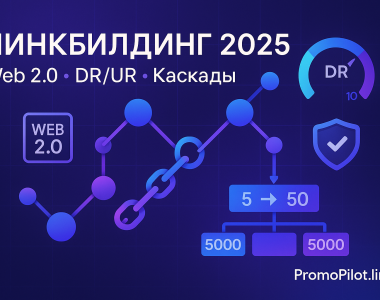Data is not a trend, not a fashion, not a pretty addition to your strategy. It’s the foundation. It’s where any effective affiliate marketing starts and ends. If you’re still acting on intuition, trusting your gut, and looking at “reach” as a measure of success – you’re heading for disaster. In 2025, marketing has become digital not only in channels but in essence. Without data, you’re blind.
The goal of this article is not to sell you a new platform (although we’re proud of it – Hyperone). It’s to break down which metrics actually matter and how to properly account for the contribution of all channels. Because if you’re still focused only on “last click” – congratulations: you’re losing money every single day.
The content of the article
Metrics That Drive Decisions
The world of metrics is divided into two parts: those that look good in reports and those that actually move the business. And unfortunately, companies usually choose the former. Because “impressions” sound impressive. Because “reach” looks big. But the truth is, they mean nothing without context.
The metrics that truly help:
Conversions (CR)
How many people actually performed the target action, not just viewed the page. If you’re driving traffic but people aren’t buying, registering, or submitting leads – you’re simply burning your budget.
EPC (earnings per click)
A metric that shows how much money you’re making per click. It reflects the quality not just of the traffic but of the combo: creative – landing page – offer.
ROI and LTV
Are partners returning the invested budget, and what is the total value the client brings over time? This is a strategic look: is it profitable for you to work with this traffic source long-term?
The real magic starts when you dig deeper. When you look at EPC not just on average, but by each partner, each landing page, specific channels, or even time of day – you start to see patterns. For example, some landing pages convert mobile Facebook traffic better, others only work via email at night. You start to see where the leaks are, and where the gold is. And you begin making decisions based not on gut feeling, but on data.
Why One Metric Isn’t Enough: Enter Attribution
A scenario familiar to all: you see in a report that a customer came from a partner. Great! Give them a bonus. But…
What about the fact that this customer was first warmed up by an email campaign, saw your YouTube banner, googled your brand, and only then clicked the affiliate link? Who contributed more? The last one? Not necessarily.
This is where the logic of the last-click model falls apart. It’s a simplified, lazy system. And it’s harmful. Because it demotivates those who create the first touches. It rewards those who just pick up a nearly converted customer. It’s unfair. And it leads to a distorted strategy.
Attribution solves this problem. There are several models:
- Linear – all touchpoints get equal weight.
- Time Decay – the closer to conversion, the higher the weight.
- Position-Based – first and last touches get more weight, the middle ones – less.
Each model gives a different view of reality. The more accurately you match the model to your funnel, the better you’ll understand what truly works.
Multichannel Attribution: A Real Look at Each Contribution
When we started using multichannel attribution, I felt like someone who got glasses after years of blindness. Suddenly I could see who and when influenced the customer. And you know what I saw? That 60% of payouts went to those who just “picked up” a warmed-up client.
The reality looks like this: the customer might first hear about you on YouTube, then land on your blog via SEO, then open a promo email, and only then – click on the affiliate link. All of these steps matter. All of them build trust. But the “last touch” model ignores that.
Multichannel attribution allows you to:
- Redistribute bonuses more fairly.
- Support channels that start the funnel.
- Build fair motivation for partners, bloggers, and SEO specialists.
How to Use Data to Optimize Strategy
Now for the most important part – how to actually use this analytics in real life.
First – budget reallocation. If you see that SEO brings in more first touches than paid search – it makes sense to invest more there. If email helps retain and return customers – add more resources to it.
Second – adjusting affiliate programs. Most only pay for conversions. But what if you also reward the first touch? Or high-quality content that brings high-converting traffic? Such bonuses encourage long-term work, not just short bursts.
Third – managing expectations. Partners no longer guess how they influence sales. They have numbers. They have trust. They have motivation to grow.
Tools and Platforms for Analytics and Attribution
Without tools – you’re nowhere. Using Excel manually in 2025 is absurd. It’s like trying to perform surgery with a kitchen knife. Sure, technically you can make some calculations, but the risk of mistakes, data loss, and inability to respond quickly – is enormous.
Today, there are dozens of solutions on the market, and choosing among them isn’t easy. Some companies still use Google Analytics as their only source of truth. Yes, it’s a working tool, especially GA4, but it’s built for general marketing tasks, not affiliate programs. Setting up end-to-end attribution there is a pain, a bunch of crutches, and constant checking of manual UTM tags. And in the end – you’re still unsure where the money came from.
If you really want to manage affiliate flows, track the actual contribution of each source, and see where profit is leaking – you need specialized platforms. RedTrack, Voluum, Affise – they don’t just offer tracking, they provide a true management system. You can set up different attribution models, define custom payout rules, block bad partners, automate payouts, and view logs for every click.
Hyros – that’s a whole other league. Not for beginners, but for those who want to see everything: from the first touch to a customer’s return six months later. It’s a system that shows exactly how the customer went through the journey: which creative brought them in, what caught their attention, when they returned, which emails they opened.
What matters when choosing:
- Availability of multichannel attribution. Without it, you live in the last-click illusion.
- Ability to set custom payout rules. Because every affiliate program is unique.
- Integrations with ad platforms, CRM, email. So data flows both ways without loss.
- Detailed logs and transparency – so you can explain any bonus, any payout, any loss.
A platform is not just a tool. It’s the foundation upon which transparency and trust are built. Without it, you can’t scale. You can’t automate. You can’t prove to your partner that they truly matter. Which means – you can’t build a long-term system.
And it’s exactly because of the lack of proper tools that so many affiliate programs collapse during the growth stage. Because everything is based on guesswork. And guesswork is the enemy of profit.
Conclusion
Analytics and attribution are not an optional block in a report. They determine where your money goes. And whether it comes back.
When you see the full picture – you make decisions with confidence, not guesswork. When your partners know their contributions are fairly valued – they perform better. When you optimize your budget based on facts, not emotions – you earn more.
It’s simple: regular analysis brings transparency. Transparency builds trust. And trust always converts into profit. It’s time to stop guessing. It’s time to start measuring.




